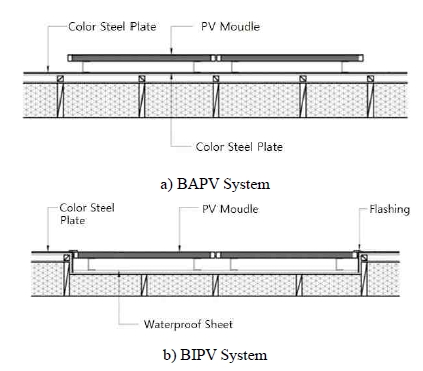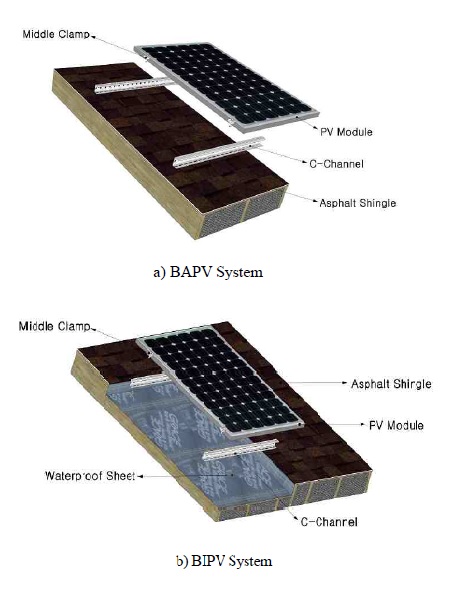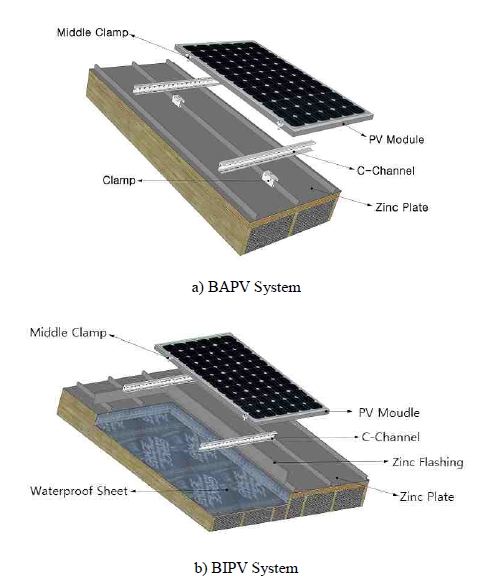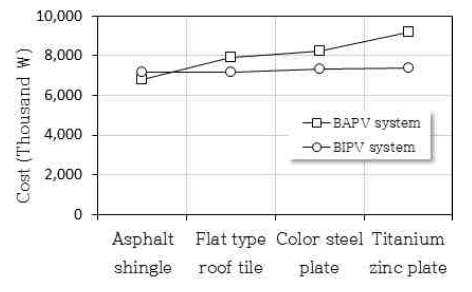
The Economic Feasibility of Building-Integrated Photovoltaics System Installed on the Roof of Residential Building
- Focused on Comparison with Construction Cost of BAPV System Depend on Roof Finishing Materials
ⓒCopyright Korea Institute of Ecological Architecture and Environment
Abstract
This study was on the economic feasibility of BIPV system, focused on comparison with construction cost of BAPV system depend on roof finishing materials, and to suggest basic data on the construction cost.
Construction cost of BAPV system was calculated, by selecting asphalt single, flat type roof tile, color steel plate, titanium zinc plate as roof finishing material of residential building and by sum up each cost for roof finishing construction and cost for 3kWp-volumed PV module installation. Also, the economic feasibility was analysed quantitatively by comparing the cost for BIPV system construction, installing same volumed PV module instead of roof finishing materials.
1. By installing BIPV system instead of the roof finishing material, the cost of construction falls ; about 19% in case of the titanium zinc plate, which is the most expensive, and about 11% in case of the color steel plate. 2. Reducing amount of the construction cost gets larger because of installing BIPV module instead of the roof finishing material, as the construction cost for roof finishing material gets higher ; therefore, it is more economical than BAPV system in terms of whole cost of construction.
Keywords:
BIPV System, Construction Cost, Roofing, Roof Finishing Materials키워드:
건물일체형 태양광발전 시스템, 공사비, 지붕공사, 지붕마감재1. Introduction
1.1. Background and Purpose of Study
According to the report of the Korea Energy Economics Institute, Korea's dependence on energy imports is as high as 95.7% in 20131), and Korea is trying to develop energy resources such as oil, natural gas, coal and uranium, no visible effect is seen. In addition, Korea's GHG reduction target announced at the Paris Climate Conference in December 2016 is 37% of the BAU emission estimate in 2030.2) The government confirmed the reduction target for manufacturing industries, considering the burden of the industry, was less than 12%, which means that even if the carbon credits are purchased overseas, the commercial, building and transport sectors are burdened with a relatively smaller burden. In this way, the use of natural energy is indispensable for the reduction of greenhouse gas emissions for solving the problems of our reality and global warming, which are absolutely lacking in natural energy, and the use of solar energy, which is a natural energy that is infinitely supplied from the sun, is essential.
Solar photovoltaic power generation system, which is one of the methods of using solar energy, can be classified into Stand-Alone Photovoltaics system, Building-Applied Photovoltaics (BAPV) system, and Building-Integrated Photovoltaics (BIPV) system depend on installation type of solar module. The advantage of the building-integrated photovoltaics (BIPV) system is to have both building materials and power generation functions as combined existing building materials with solar cells by applying to building envelope by making solar module as building material, and to increase the efficiency of the solar photovoltaic system by raising the economical efficiency as well as various added value.3) In addition, it has been known that replacing existing building envelope finishing materials with PV modules can have side effects that reduce facility cost.4)
A study on the economical efficiency of the BIPV system, Barbose, G. et al.5) has reported by year construction cost of the BIPV system and stand-alone photovoltaics system to produce electricity 1W, but the roof material cost reduced due to the installation of BIPV was not included in the calculation. In addition, Kim et al.6) analyzed LCC including finishing materials replacement costs, power generation, lighting energy, and cooling and heating load reduction to secure the economical efficiency of the amorphous BIPV system installed in windows, but it examined the economic benefits of light-emitting amorphous BIPV rather than reduction of the construction cost.
The new and renewable energy installation standard unit cost of Korea Energy Agency's New and Renewable Energy Center7) also announced by year construction cost of BIPV system and Stand-Alone Photovoltaics system to produce electricity 1W, but as the roof material cost reduced due to installation of BIPV is not included in the calculation, actual Photovoltaic construction cost including roof construction cost was not compared.
It has been known that the BIPV system reduces the construction cost by replacing the building envelope material with the photovoltaic module, but the actual amount of the construction cost is not presented as to how the actual construction cost changes. In other words, the results of the study on how economical is the BIPV system compared to the BAPV system (BAPV) system and how different the economical efficiency is according to the finishing materials of the roof have not been announced. In this study, we intend to compare and study the economical efficiency of BIPV system for roof finishing materials quantitatively with the BAPV system and present its basic data.
1.2. Method and Scope of Study
The solar module can be installed on the roof or wall of the building, or in the opening part by using lighting type (transparent or translucent) solar cell. In addition to these areas, it is possible to install rooftop, sunscreen, and balconies integrated with the building, but it is desirable to install it in a place where the sunshine conditions are good and the shadows of other parts are not affected in order to obtain a large amount of electricity. In this study, we intend to change the type of finishing materials and compare with the BAPV system, focusing on the installation cost of the system on the economic effect of the BIPV system, which reduces the installation cost by replacing the roof finishing materials with the solar module installed on the roof.
There are many different types of roof finishing materials, but here are selected 4 types of roof materials such as the asphalt shingle, flat type roof tile, color steel plate, Titanium zinc plate, which are commonly used as roof finishing materials for residential buildings. We calculated the construction cost of BAPV system by adding 3kWp photovoltaic module installation cost in the form of BAPV system on top of each roof construction cost and finishing materials, and substituting the same finishing materials and the BIPV system construction cost of installing the solar module of the photovoltaic module is calculated and compared to analyze economical efficiency quantitatively.
Fig. 1 is an example of the case where the roof finishing materials are color steel plates, and replacing the BAPV system (a) and finishing materials, a section view of BIPV system (b) installing solar module.
As shown in the figure, in case of the BAPV system, the supporting structure is placed on the roof finishing materials and the solar module is installed on that. On the other hand, in the case of the BIPV system, the roofing finishing materials are not installed and waterproofing works such as installing a waterproof sheet to prevent rainwater from penetrating the site, and a supporting structure is placed thereon, and a solar module is buried and installed. At this time, in case the roof finishing material is steel plate material such as color steel plate and Titanium zinc plate, finishing material such as roof is used on the incision side to install the solar module and install flashing which is rainwater-proof construction (see Fig .3) If the BIPV system is installed on the roof finishing material instead of installing the BAPV system, the roof finishing area is reduced and the construction cost is reduced. However, the waterproofing work and the flashing installation are required, which may increase the construction cost.
Fig. 2 shows in case the roof finishing materials are asphalt shingle, and Fig. 3 is drawn in the form of exploded view of (a) BAPV system and (b) BIPV system in case the roof finishing materials are Titanium zinc plate.
In case the roof finishing materials are asphalt shingle or flat type roof tiles, there is no need to install flashing like Fig. 2, but in case the roof finishing materials are steel plate materials such as color steel plate and Titanium zinc plate, flashing should be installed on the incised side using the same finishing materials as the roofing material to install the photovoltaic module like Fig. 3.
2. Calculation of Construction Cost
2.1. Unit Cost by Roof Finishing Materials
In order to prepare the unit cost for the installation work of four types of roof finishing materials for residential buildings, which are asphalt shingle, flat type roof tile, color steel plate, Titanium zinc plate, the materials and products are based on the government-standardized calculation and the items not specified in the standard calculation are based on the calculation commonly used in the construction work. The construction costs per unit area (㎡) by roof finishing materials as shown in (a) to (d) of Table 1 are applied to unit price of the price data sheet in 2016 and the labor unit price of government in the first half of 2016.
Following Table 2 summarizes Table 1, which is the unit cost by roof finishing materials.
Comparing the roof construction cost per unit area (㎡), it shows that the titanium zinc plate is the most expensive at 158,757 won, because the material cost is high and labor cost is high, and asphalt shingle is the cheapest at 38,955 won. Comparing this by ratio, the construction cost of the most expensive titanium zinc plate showed more that four times as much as that of the cheapest asphalt shingle. In this way, since there is a great difference in the construction cost of roof construction depending on the finishing materials, economic efficiency is different depending on whether the BIPV system installs solar module in place of which finishing materials. Therefore, in this study, we intend to examine the economical efficiency by comparing the construction cost with each other how different the construction cost according to the roof finishing materials replaced with the photovoltaic module of the form of BIPV is.
2.2. Installation Construction Cost of Photovoltaics System
Table 3 shows the cost of installing 3 kWp crystalloid photovoltaic module installed in the form of BAPV system on top of the roof finishing material, which is a construction cost only for pure photovoltaic module installation, except for the roof construction cost, ie, roof finishing materials, material cost or labor cost for installation.
As shown in the above table, the construction cost of photovoltaic module with 3kWp capacity of BAPV system is calculated to be about 6 million won plus material cost and labor cost.
3. Economical Efficiency Comparison
The economic efficiency is analyzed by calculating and comparing the construction cost of photovoltaic module with capacity of 3 kWp installed in the form of BAPV system on top of each roof finishing material and the construction cost of photovoltaic modules of the same capacity installed in the form of BIPV system by replacing finishing materials.
3.1. Construction Cost of BAPV system
Table 4 shows photovoltaic construction cost calculated including roof finishing when installing BAPV system with capacity of 3kWp on the roof, which is the addition of roof construction cost of 20㎡ multiplied by the cost per unit area of each finishing materials in Table 1, and construction cost for BAPV system of 3kWp. At this time, the roof area of 20㎡ is the roof area required to install 3kWp of photovoltaic capacity assuming that the efficiency of the crystalloid type photovoltaic module is 15%. Therefore, the roof construction cost in Table 4 is obtained values by multiplying the unit cost of Table 1 by photovoltaic installation area of 20㎡.
As shown compared in Table 2, the roof construction cost for Titanium zinc plate, the most expensive in material cost and labor cost, was more than four times than that of the cheapest asphalt shingle, which showed about 1.35 times more expensive, or about 35% in case of including photovoltaic construction cost.
3.2. Construction Cost of BIPV system
Table 5 shows the construction cost calculated 20㎡ of BIPV system with capacity of 3kWp, which is the addition of construction cost for integrating with roof and construction cost for BAPV system of 3kWp
Since the part where the roof finishing material of the BAPV system is installed is replaced with the photovoltaic module, the construction cost for roofing is excluded from the BAPV system cost of Table 4.
The construction cost for integrating with the roof includes floor waterproofing, preparation for installation of photovoltaic modules, etc., which are not necessary for installing BAPV system. Especially, in case roof finishing Materials are steel plate materials such as color steel plate or Titanium zinc plate, since it should install flashing which is rainwater-proof construction using the same finishing material as the roof material on the incision side to install the photovoltaic module (see Fig .3), the material cost and the labor cost are increased, and the construction cost is increased as compared with the asphalt single type or flat type roof tile.
In the Table 5, ‘the construction cost for BAPV of 3kWp’ is pure photovoltaic module installation cost which come from Table 3 as it was except for the roof finishing construction. Photovoltaic module installation cost of BAPV system and BIPV system is basically the same (see Fig.1).
Comparing the cost of BIPV system according to roof finishing materials, Titanium zinc plate, the most expensive roof finishing material, is about 3% more expensive compared to the asphalt shingle, the cheapest construction cost due to the difference of material cost such as rainwater-proof construction and labor cost, but this is very small compared to the 35% difference in BAPV system cost of Table 4. Though there is a big difference in the construction cost of BAPV system due to the large difference in construction cost of roof finishing materials, there is no big difference because BIPV system construction cost do not include roof finishing materials.
3.3. Comparison of Construction Cost
Following table 6 summarizes the Table 4, the construction cost of the BAPV system, and Table 5, the construction cost of the BIPV system.
For the ratio of construction cost of BIPV system to construction cost of BAPV system(b/a), in case of asphalt shingle with relatively low roof construction cost, if BIPV type photovoltaic module instead of roof material and BAPV was installed, the roof finishing construction cost increased by 6%, but in case of the other three types of roof materials, if BIPV type photovoltaic module instead of BAPV was installed, the cost of construction reduced and it was economical.
Particularly, in the case of Titanium zinc plate, the most expensive in roof construction cost, if BIPV type photovoltaic module was installed instead of the roof finishing material, the roof construction cost reduced by 19%. In case of the next expensive color steel plate, it reduced by about 11%.
In other words, as the cost of finishing materials is higher, the cost of BIPV type photovoltaic module is reduced, which is more economical than BAPV in terms of overall construction cost.
Fig. 4 shows graphs for easier comparison in Table 6 above. BIPV is more economical in all three cases except for asphalt shingle as roof finishing materials, and especially, in case of Titanium zinc plate with expensive roof construction cost, it can be seen that the difference of the construction cost is larger.
4. Conclusion
In this study, by calculating each construction cost for the subject of 4 types of roof finishing materials such as asphalt shingle, flat type roof tile, color steel plate, Titanium zinc plate, which are commonly used as roof finishing materials for residential buildings, BAPV system construction cost combined photovoltaic construction cost when 3 kWp photovoltaic module is installed in the form of BAPV system on top of these finishing materials, and BIPV system construction cost installed with the same capacity of photovoltaic modules in the form of BIPV system in place of finishing materials, the following results were obtained by quantitatively comparing the economical efficiency focused on the roof finishing construction cost.
1. When installing BIPV system instead of roof finishing material, it was analyzed that the construction cost Titanium zinc plate, which is the most expensive roof finishing construction cost, reduced by about 19%, and that of color steel plate also reduced by about 11%,
2. In case of asphalt shingle, which has the cheapest roof finishing construction cost, it is calculated that the construction cost increased by about 6% in case of replacing with BIPV system.
In this study, it is found that the higher the construction cost of roof finishing material is, the more reduced the construction cost is due to the BIPV installed replacing roof finishing material, so it is more economical than BAPV in terms of overall construction cost. In order to expand the BIPV system in the future, it is considered to need additional study of LCC analysis, etc. including power generation amount and recently revised electricity billing system considering the efficiency difference between the two systems.
Acknowledgments
This work was supported by Shinhan University Research Fund, 2016
References
- Korea Energy Economics Institute, Yearbook of Energy Statistics, Statics in Chart, p21, (2014).
- KOREA ENERGY AGENCY, A News Release, (2016, Nov, 29).
- Jongho Yoon, (2008, Aug), BiPV, New Wave of Building Integrated Photovoltaics System, Korea Institute of Registered Architects, Korean Architects, p67.
- Yoon, Jongho, Kim, J.I, Lee, K.S., Yu, G.J., Development of Building Integrated PV(BIPV) module for the replacement of commercial building envelope materials“, The International Journal of The Korea Institute of Ecological Architecture and Environment, 4(3), (2004).
- Barbose, G., et al , (2011), Tracking The Sun Ⅳ : An Historical Summary of the Installed cost of Photovoltaics in the United States from 1998 to 2010, Berkeley, CA, Lawrence Berkeley National Laboratory.
- Lee, Han-Myoung, Oh, Min-Seok, Kim, Hway-Suh, “A Study on the Life Cycle Cost Analysis of the See-thorough a-si Building Integrated Photovoltaic System”, Journal of the Korean Solar Energy Society, 29(1), (2009).
- KOREA ENERGY AGENCY, New and Renewable Energy Center, Unit Cost for Construction of New and Renewable Energy, (2012).




